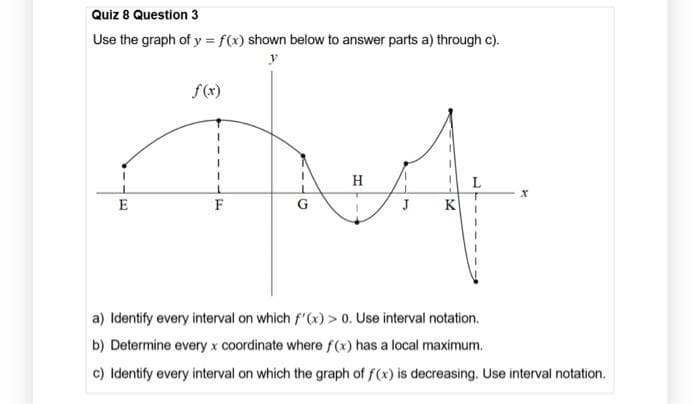Use the graph of y = f(x) shown below to answer parts a) through c). Mhesh F J K E f(x) X a) Identify every interval on which f'(x) > 0. Use interval notation. b) Determine every x coordinate where f(x) has a local maximum. c) Identify every interval on which the graph of f(x) is decreasing. Use interval notation.
Use the graph of y = f(x) shown below to answer parts a) through c). Mhesh F J K E f(x) X a) Identify every interval on which f'(x) > 0. Use interval notation. b) Determine every x coordinate where f(x) has a local maximum. c) Identify every interval on which the graph of f(x) is decreasing. Use interval notation.
Algebra & Trigonometry with Analytic Geometry
13th Edition
ISBN:9781133382119
Author:Swokowski
Publisher:Swokowski
Chapter3: Functions And Graphs
Section3.5: Graphs Of Functions
Problem 59E
Related questions
Question
Dd.3.

Transcribed Image Text:Quiz 8 Question 3
Use the graph of y = f(x) shown below to answer parts a) through c).
y
f (x)
Aut
F
E
H
K
X
a) Identify every interval on which f'(x) > 0. Use interval notation.
b) Determine every x coordinate where f(x) has a local maximum.
c) Identify every interval on which the graph of f(x) is decreasing. Use interval notation.
Expert Solution
This question has been solved!
Explore an expertly crafted, step-by-step solution for a thorough understanding of key concepts.
This is a popular solution!
Trending now
This is a popular solution!
Step by step
Solved in 3 steps

Recommended textbooks for you

Algebra & Trigonometry with Analytic Geometry
Algebra
ISBN:
9781133382119
Author:
Swokowski
Publisher:
Cengage

Algebra & Trigonometry with Analytic Geometry
Algebra
ISBN:
9781133382119
Author:
Swokowski
Publisher:
Cengage